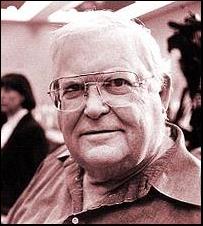William Webber’s memory of fire
By Michael Collins
LA Weekly – April 21, 1999
 In conducting two detailed long-term health surveys of Rocketdyne employees, UCLA scientists have necessarily focused on the results of working for a firm that helped pioneer the space race.
In conducting two detailed long-term health surveys of Rocketdyne employees, UCLA scientists have necessarily focused on the results of working for a firm that helped pioneer the space race.
William Webber offers a glimpse of how it all happened.
A rocket scientist who spent a total of 18 years with Rocketdyne, Webber retired in 1988, and has since become the only former employee to assert publicly that dangerous chemicals were mishandled, that lab workers were routinely exposed to hazards and that warnings to company supervisors were ignored. The company disputes his charges, but the UCLA studies indicate that something may well have gone awry at Rocketdyne.
Think of it as sausage making with a military-industrial edge. According to Webber, it wasn’t a pretty process. Supervising more than a thousand tests of experimental engines at a Rocketdyne facility in El Segundo, Webber was particularly concerned over tests of a small experimental engine that used a total of 754 pounds of the carcinogenic chemical nitrogen tetraoxide (NTO). The fuel was occasionally spilled, released to the atmosphere and splashed on workers, Webber said — to ill effect.
“All hydrazines are carcinogens,” the retired scientist asserted. “The other half of the propellant team, which is the oxidizer, is nitrogen tetraoxide, and it is a very volatile liquid. As soon as it spills, it oxidizes and turns into a heavy gas. A heavy gas, if it gets in your lungs, forms nitric acid and nitrous acid. It inflames the lungs, and what kills you is flooding of the lungs — the same action the war gas phosgene does. If you get a heavy dose, you can be dead in a matter of minutes.”
Webber contends that the presence of nitrogen tetraoxide and other workplace hazards led to a series of mishaps, such as one incident of exposure to a rocket fuel that caused workers to lose involuntary motor coordination. Webber maintains his composure as he describes workers crawling off to seek help, their tongues lolling out and heads slumped over.
But the rocket scientist is reduced to tears when describing the death of his test mechanic, Milo Tibbetts. Webber believes Tibbets died of overexposure to hydrazine. “We used that stuff like it was water,” he said between sobs. Rocketdyne denies there is any proven link between hydrazine exposure and worker deaths.
In an October 4, 1987, memo, Webber warned Rocketdyne senior vice presidents R.A. DePalma and C.H. Harff, as well as the office of Rocketdyne’s general auditor, about this recipe for disaster. Webber stated that the tests violated clean-air standards and that a cloud of spilled NTO could drift into LAX or the adjacent residential neighborhood and kill people. He added in the memo that “the reply from supervision was, ‘It doesn’t matter if we kill a few people with our testing, because Rockwell has a large legal staff that can take care of that kind of thing.'”
The company responded by challenging Webber’s facts and expertise. In a January 22, 1988, memo from Rockwell, then Rocketdyne’s owner, the company claimed that there were only 25 pounds of NTO on-site. (Webber produced his own documentation for the Weekly indicating that there were actually 754 pounds of NTO at the locale at the time.)
The Rockwell memo also disputes the statement he attributed to company supervisors. “It does not represent Company policy and is expressly disapproved. Rockwell is mindful of the dangers of NTO, and its use at [the El Segundo facility] and is subject to very strict controls,” the memo said.
During the same period of time, a cloud of caustic gas had allegedly drifted off the El Segundo facility into an adjacent fire station, sickening a group of firefighters.
Soon after he filed his complaint, Webber was given an “unsatisfactory” rating; it was changed to “satisfactory” only after an administrative hearing.
“I refused to fire that [fuel] at El Segundo. Therefore, you are a bad guy, you’re not a team player, you don’t follow company principles and objectives,” said Webber.
The whistle-blowing scientist added that, in his estimation, some of the health problems associated with Rocketdyne experiments were inadvertent and could not be avoided. “You can’t blame them much for that. But when they know about it completely and lie about it, then you really start to have a different take on it.”
27 Years of Award-Winning SSFL/Rocketdyne Reporting
1998 – 2025












Recent Comments